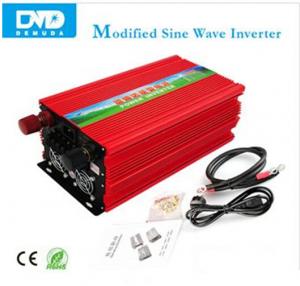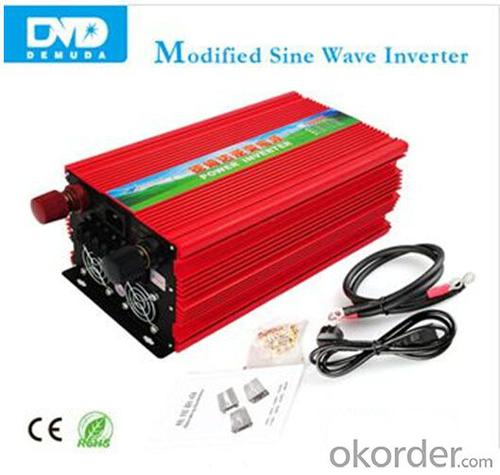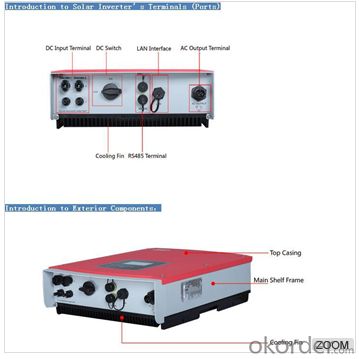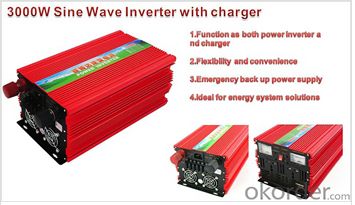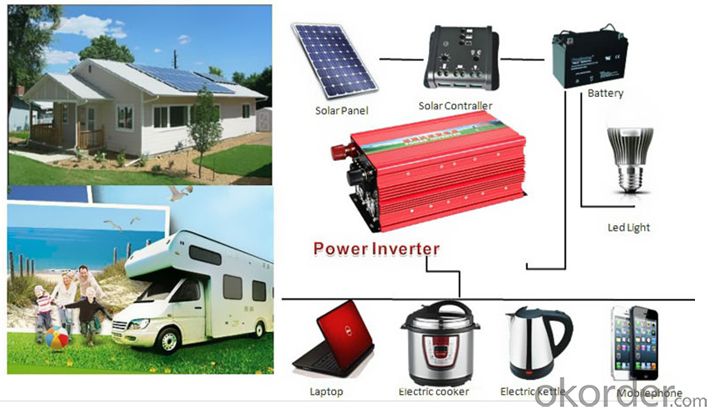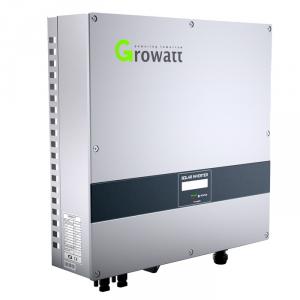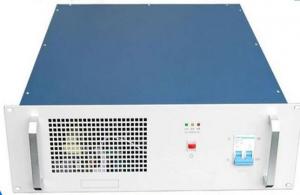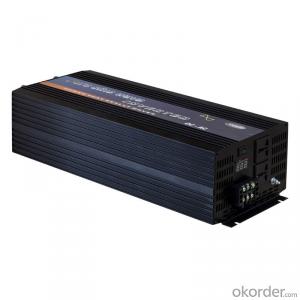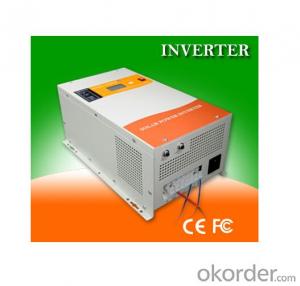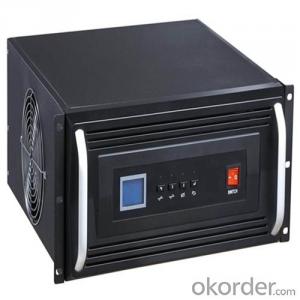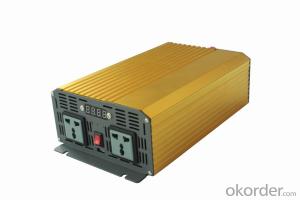3ph Solar Inverter Modified Sine Wave 3000W
- Loading Port:
- China main port
- Payment Terms:
- TT or LC
- Min Order Qty:
- 50 unit
- Supply Capability:
- 1000 unit/month
OKorder Service Pledge
OKorder Financial Service
You Might Also Like
1. Structure of Solar Inverter, High quality Single Phase Modified Sine Wave 3000w Description
The inverter series is an electronic product that has been designed and built to take low DC woltage power from batteries and convert it to
standard AC power like the current you have at home.
The Inverter series is a DC-to-AC with auto line-to-battery transfer and intergrated charging system. Inverter series powers from ACpower
and DC source, serving as an extended run UPS. When AC cable is connected to a wall socket, utility power goes to connected equipment
and/or charges the battery set via charging system. In Inverter mode, the Inverter series automatically converts battery energy into AC power
for backing up the connected devices.
2. Main Features of Solar Inverter, High quality Single Phase Modified Sine Wave 3000w
• Low voltage protection
• Over voltage protection
• Overload protection
• Over temperature protection
• Short circuit protection
3. Solar Inverter, High quality Single Phase Modified Sine Wave 3000w Images
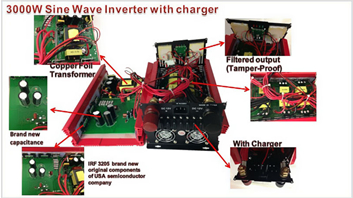
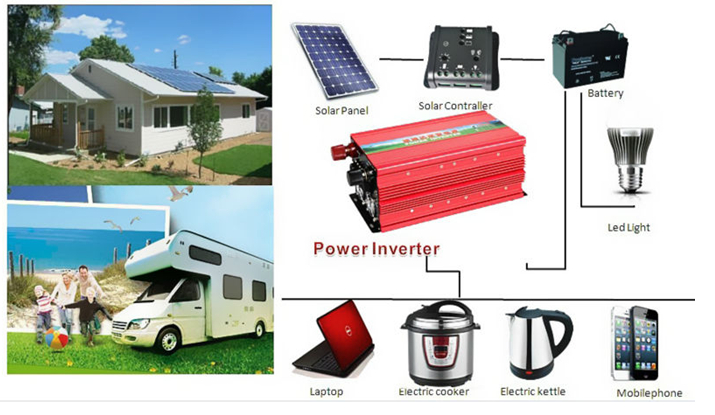

4. Solar Inverter, High quality Single Phase Modified Sine Wave 3000w Specification
Model No. | DMD-3000W/24V/F/CA | |
Input Section | DC Input Voltage | 24V |
DC Operating Voltage | 21-29V | |
DC Low-voltage Protection | 18.5-20.5V | |
DC Low-voltage Alarm | 19.5-21V | |
DC Over-voltage Protection | ≥29V | |
Fuse | 20A*2 | |
Quiescent Current | ≤0.5A | |
Output Section | Output Waveform | Modified Sine Wave |
Output Voltage | 220V±10% | |
Output Frequency | 50Hz±1% | |
Power Rating | 3000W | |
Continue Output Rating | 3000W | |
Peak Power Rating Output | 6000W | |
Transfer Efficiency | ≥90 % | |
Overload Protection | 3000W--3600W | |
Short-circuit Protection | Yes | |
Operating Temperature | -10°C--+50°C | |
Temperature Protection | +60°C--+70°C | |
Green LED Indicator | Green Light(Working),Flash(Overload Protection) | |
Red LED Indicator | Red Light(Error Protection) | |
Size | Size: 305 x 165 x 125mm | |
Weight | 5.5kg | |
Packing | Color box packing or skin packing | |
5. FAQ of Solar Inverter, High quality Single Phase Modified Sine Wave 3000w
Q1:Can we visit your factory?
A1:Sure,welcome at any time,seeing is believing.
Q2:Which payment terms can you accept?
A2:T/T,L/C,Moneygram,Paypal are available for us.
- Q: How does a solar inverter handle varying solar irradiance levels?
- A solar inverter handles varying solar irradiance levels by continuously monitoring the incoming solar power and adjusting its output accordingly. It employs a maximum power point tracking (MPPT) algorithm that optimizes the energy conversion from the solar panels to the desired AC power output. When solar irradiance levels fluctuate, the inverter dynamically adapts to ensure the maximum power is extracted from the solar panels. This allows for efficient energy conversion and maximum utilization of the available solar power.
- Q: Can a solar inverter be used with different types of power factor correction devices?
- Yes, a solar inverter can be used with different types of power factor correction devices. Power factor correction devices are designed to improve the power factor of electrical systems and reduce reactive power. Solar inverters convert the DC power generated by solar panels into AC power that can be used in the electrical system. The power factor correction devices can be installed in conjunction with the solar inverter to improve the overall power factor of the system and enhance its efficiency.
- Q: How does a solar inverter protect against power surges?
- A solar inverter protects against power surges by incorporating surge protection devices and circuitry within its design. These devices are designed to detect and divert excessive voltage levels caused by power surges, thereby preventing damage to the inverter and the connected solar panels.
- Q: How does a solar inverter communicate with other devices in a solar power system?
- A solar inverter communicates with other devices in a solar power system through various communication protocols and interfaces. One common method is through wired connections using communication interfaces such as RS485 or Ethernet. These interfaces allow the inverter to establish a direct connection with other devices such as solar panels, batteries, and monitoring systems. In addition to wired connections, wireless communication methods are also used. This includes technologies like Wi-Fi, Zigbee, or Bluetooth, which enable the inverter to connect with other devices within a certain range. Wireless communication is often used for monitoring and control purposes, allowing users to remotely access and manage their solar power system. The communication between the solar inverter and other devices is crucial for the overall performance and efficiency of the solar power system. It enables the inverter to receive important data from the solar panels, such as voltage, current, and temperature, which is necessary for optimal power conversion. The inverter can then adjust its operations based on this information to maximize the power output and ensure system safety. Furthermore, communication with other devices like batteries allows the solar inverter to manage the charging and discharging cycles, optimizing energy storage and utilization. This ensures that excess energy generated by the solar panels is efficiently stored in the batteries and used during periods of low sunlight. Overall, the communication capabilities of a solar inverter play a crucial role in the integration and coordination of different components within a solar power system. It enables efficient power conversion, monitoring, and control, ultimately maximizing the performance and benefits of solar energy generation.
- Q: What is the role of a frequency regulation feature in a solar inverter?
- The role of a frequency regulation feature in a solar inverter is to ensure that the power output from the solar panels matches the grid's frequency and voltage requirements. It helps maintain a stable and consistent frequency, allowing for seamless integration of solar power into the existing electrical grid.
- Q: How does a solar inverter handle voltage and frequency variations caused by voltage sags and swells?
- A solar inverter handles voltage and frequency variations caused by voltage sags and swells by monitoring the input voltage and frequency constantly. When it detects a variation, it employs internal control mechanisms to adjust the output voltage and frequency accordingly. This ensures that the solar inverter delivers stable and reliable power to the connected load, even during voltage fluctuations.
- Q: How does a solar inverter synchronize with the grid frequency?
- A solar inverter synchronizes with the grid frequency by continuously monitoring the frequency of the electrical power supplied by the grid. It adjusts its own output frequency to match the grid frequency using a built-in control mechanism. This synchronization ensures that the solar inverter's power is in phase with the grid power, allowing it to smoothly inject electricity into the grid without causing disruptions or power quality issues.
- Q: What are the key considerations for selecting a reliable solar inverter manufacturer?
- When selecting a reliable solar inverter manufacturer, there are several key considerations to keep in mind. Firstly, it is important to assess the manufacturer's reputation and track record in the industry. Look for manufacturers with a solid history of producing high-quality and durable inverters. Secondly, evaluate the manufacturer's warranty and after-sales support. A reliable manufacturer should offer a comprehensive warranty that covers both the product and its performance. Additionally, they should have a responsive customer support team that can assist with any inquiries or issues that may arise. Thirdly, consider the efficiency and performance of the inverters offered by the manufacturer. Look for inverters that have high conversion efficiency, which can maximize the solar energy generation and optimize the system's overall performance. Furthermore, it is crucial to assess the manufacturer's compliance with industry standards and certifications. Look for manufacturers that adhere to recognized quality standards and have certifications such as ISO 9001 and IEC 62109. Lastly, consider the manufacturer's financial stability and longevity. A reliable manufacturer should have a strong financial standing and be well-established in the market. This ensures their ability to honor warranties and provide ongoing support. By considering these key factors, you can select a reliable solar inverter manufacturer that offers high-quality products, excellent customer support, and a strong reputation in the industry.
- Q: Can a solar inverter be used with solar-powered signage systems?
- Yes, a solar inverter can be used with solar-powered signage systems. A solar inverter is responsible for converting the direct current (DC) produced by the solar panels into alternating current (AC) that can be used to power electrical devices. Since solar-powered signage systems also require AC power to operate, a solar inverter is necessary to ensure compatibility and efficient energy conversion.
- Q: Can a solar inverter be used with a solar-powered data center?
- Yes, a solar inverter can be used with a solar-powered data center. A solar inverter is responsible for converting the direct current (DC) generated by solar panels into alternating current (AC) that can be used to power electrical devices. In the case of a solar-powered data center, the solar inverter would play a crucial role in converting the DC electricity produced by the solar panels into AC electricity that can be used to power the data center's servers, cooling systems, and other equipment.
Send your message to us
3ph Solar Inverter Modified Sine Wave 3000W
- Loading Port:
- China main port
- Payment Terms:
- TT or LC
- Min Order Qty:
- 50 unit
- Supply Capability:
- 1000 unit/month
OKorder Service Pledge
OKorder Financial Service
Similar products
Hot products
Hot Searches
Related keywords
